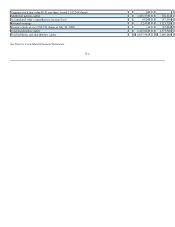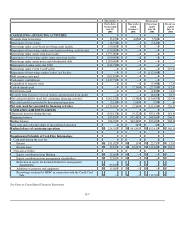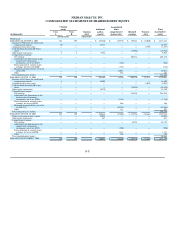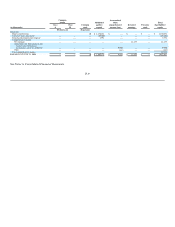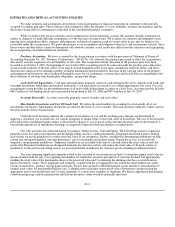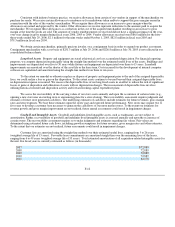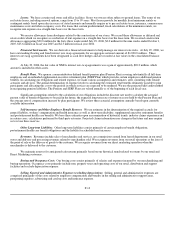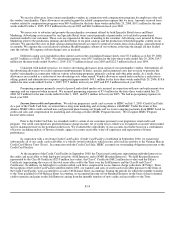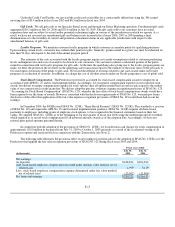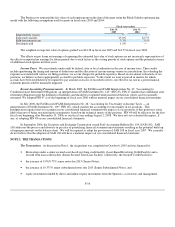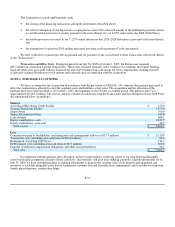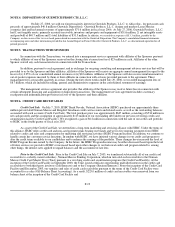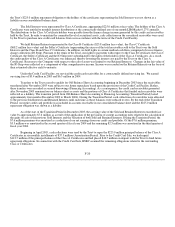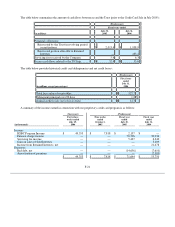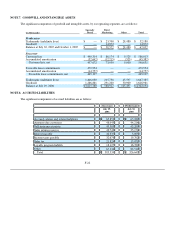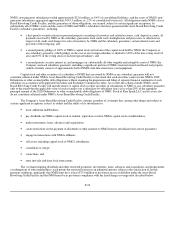Neiman Marcus 2005 Annual Report Download - page 93
Download and view the complete annual report
Please find page 93 of the 2005 Neiman Marcus annual report below. You can navigate through the pages in the report by either clicking on the pages listed below, or by using the keyword search tool below to find specific information within the annual report.
We receive allowances from certain merchandise vendors in conjunction with compensation programs for employees who sell
the vendors' merchandise. These allowances are netted against the related compensation expense that we incur. Amounts received from
vendors related to compensation programs were $49.4 million for the forty-three weeks ended July 29, 2006, $10.1 million for the nine
weeks ended October 1, 2005, $53.2 million in fiscal year 2005 and $46.3 million in fiscal year 2004.
We incur costs to advertise and promote the merchandise assortment offered by both Specialty Retail stores and Direct
Marketing. Advertising costs incurred by our Specialty Retail stores consist primarily of print media costs related to promotional
materials mailed to our customers. These costs are expensed at the time of mailing to the customer. Advertising costs incurred by Direct
Marketing relate to the production, printing and distribution of our print catalogs and the production of the photographic content on our
websites. We amortize the costs of print catalogs during the periods we expect to generate revenues from such catalogs, generally three to
six months. We expense the costs incurred to produce the photographic content on our websites at the time the images are first loaded
onto the website. We expense website design costs as incurred.
Deferred catalog costs included in other current assets in the consolidated balance sheets were $7.0 million as of July 29, 2006
and $8.7 million as of July 30, 2005. Net advertising expenses were $99.3 million for the forty-three weeks ended July 29, 2006, $14.7
million for the nine weeks ended October 1, 2005, $117.5 million in fiscal year 2005 and $122.3 million in fiscal year 2004.
Consistent with industry practice, we receive advertising allowances from certain of our merchandise vendors. Substantially all
the advertising allowances we receive represent reimbursements of direct, specific and incremental costs that we incur to promote the
vendor's merchandise in connection with our various advertising programs, primarily catalogs and other print media. As a result, these
allowances are recorded as a reduction of our advertising costs when earned. Vendor allowances earned and recorded as a reduction to
selling, general and administrative expenses aggregated approximately $43.1 million for the forty-three weeks ended July 29, 2006, $18.6
million for nine weeks ended October 1, 2005, $57.5 million in fiscal year 2005 and $55.3 million in fiscal year 2004.
Preopening expenses primarily consist of payroll and related media costs incurred in connection with new and replacement store
openings and are expensed when incurred. We incurred preopening expenses of $7.4 million for the forty-three weeks ended July 29,
2006, $3.9 million for the nine weeks ended October 1, 2005, and $5.9 million in fiscal year 2005. We had no preopening expenses in
fiscal year 2004.
Income from credit card operations. We sold our proprietary credit card accounts to HSBC on July 7, 2005 (Credit Card Sale).
As a part of the Credit Card Sale, we entered into a long-term marketing and servicing alliance with HSBC. Under the terms of this
alliance, HSBC offers credit card and non-card payment plans bearing our brands and we receive ongoing payments from HSBC based on
credit card sales and compensation for marketing and servicing activities (HSBC Program Income). We recognize HSBC Program
Income when earned.
Prior to the Credit Card Sale, we extended credit to certain of our customers pursuant to our proprietary retail credit card
program. Our credit card operations generated finance charge income, net of credit losses, which was recognized as income when earned
and we maintained reserves for potential credit losses. We evaluated the collectibility of our accounts receivable based on a combination
of factors, including analysis of historical trends, aging of accounts receivable, write-off experience and expectations of future
performance.
In connection with a revolving Credit Card Facility (Credit Card Facility) established in September 2000, we transferred
substantially all of our credit card receivables to a wholly-owned subsidiary which in turn sold such receivables to the Neiman Marcus
Credit Card Master Trust (Trust). In connection with the Credit Card Sale, HSBC assumed our outstanding obligations pursuant to the
Credit Card Facility.
At the inception of the Credit Card Facility in September 2000, the Trust issued certificates representing undivided interests in
the credit card receivables to both third-party investors (Sold Interests) and to NMG (Retained Interests). We held Retained Interests
represented by the Class B Certificate ($23.8 million face value), the Class C Certificate ($68.2 million face value) and the Seller's
Certificate (representing the excess of the total receivables sold to the Trust over the Sold Interests and the Class B and Class C
Certificates). In addition, we held rights to certain residual cash flows comprised of excess finance charge collections (IO Strip). From
the inception of the Credit Card Facility until December 2003, our transfers and sales of credit card receivables pursuant to the terms of
the Credit Card Facility were accounted for as sales (Off-Balance Sheet Accounting). During the periods for which the monthly transfers
to the Trust qualified for Off-Balance Sheet Accounting, we recognized income on our Retained Interests on the basis of their estimated
yield to maturity and gains on the Sold Interests arising from the monthly transfers of new credit card receivables to the Trust.
F-14


